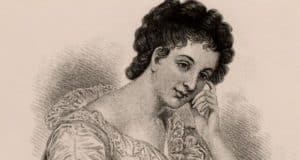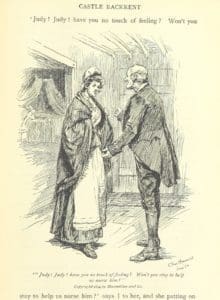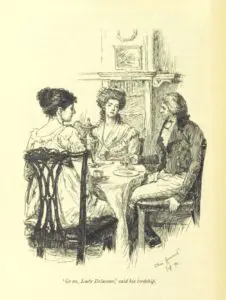Irish Author Maria Edgeworth and her Life Work

Updated On: November 07, 2023 by Ciaran Connolly
Maria Edgeworth is another famous author from our Island called Ireland. She created many children and adult novels throughout her life and played a role in the evolution of the Novel across Europe.
Continue reading below to discover the life and work of Irish Author Maria Edgeworth.
Early Life

Sourced: Irish Times, Universal History Archive
Surprisingly Maria Edgeworth was not born in Ireland, but was actually born in Black Bourton, Oxfordshire, England. She was the second born child of her father, Richard Lovell Edgeworth, and mother Anna Maria Edgeworth. She remained in England until her mother died, then moved to Ireland with her father and his second wife (Honora Sneyd). They lived in Edgeworthtown, in County Longford. Soon after, in 1775, Honora fell ill and young Maria was sent to Derby to attend school. Then, in 1780 she moved to London and attended school there as her father married Honora’s sister.
At the young age of 14, the young Maria returned to Ireland to care for her siblings and was educated at home by her father. Later, helping her father manage the Edgeworthian estate. From this young age she started writing about Irish life from watching her extended family and many servants and tenants around the estate. These recordings later influenced her later writings.
Throughout her life she traveled across Europe with her family while writing. However, she spent the rest of her life living in the Edgeworthstown estate. She became very famous and was compared alongside Jane Austen and Sir Walter Scott, earning more than them.
Maria Edgeworth Books
Throughout her literary career, Maria Edgeworth wrote many novels which are read and studied today. Here we have listed some of books with summaries, quotes and themes.
Look here to find a list of all Maria Edgeworth’s work from her literary career.
Maria Edgeworth “Castle Rackrent” Summary

Sourced: Flickr, British Library
“Castle Rackrent” is regarded as the first of many types of novel, including: the first historical novel, the first Anglo-Irish novel, the first saga novel, and the first regional novel written in English.
Castle Rackrent by Maria Edgeworth was published in 1800. This short story and is set before the 1782 Constitution. It follows the decline of the Rackrent family through four generations, and is narrated through the family’s steward named Thady Quirk.
He begins by explaining that his grandfather was a driver for Patrick O’Shaughlin who descended from the Kings of Ireland. However, due to English colonization and Anglicization of Ireland, to keep his land he was forced to change his name to Rackrent (Under Act of Parliament). When Patrick loses his life to alcohol consumption, his son Murtagh takes over. However, he ends up losing a lot of the family money in lawsuits. Therefore, he attempts to regain some wealth by digging into a fairy mount. He then become afflicted with mortal sickness and dies shortly after. He is then succeeded by officer Kit Stopgap. He relocates to Bath and loses a lot of money to gambling and due to this ends up in debt. He marries a Jewish woman in hope she will give him wealth, when she opposes he locks her up for seven years. He is killed in a fight and the woman is freed.
Fourth, and last, in line is Connoly Rackrent, nickname Condy. He seems to be Thady’s favourite as he knew him from he was a child and as he went to a grammar school along with Thady’s son Jason. Before inheriting the estate he became a Lawyer. He refuses to handle the debt build up by his ancestors and gives the responsibility to Jason. They bargain and Connoly gives Jason some land. He later sells the hunting lodge on the estate to the Moneygawl family. He later marries Mr Moneygawls youngest daughter. Condy’s debt grows and Jason offers to buy the estate. Condy agrees and soon after signing, dies. The narrator seems more sad about Condy’s death, than happy by his son’s new ownership and class ascent.
Quotes
“When a man’s over head and shoulders in debt, he may live the faster for it, and the better if he goes the right way about it, or else how is it so many live so well, as we see every day after they are ruined?”
“Thady begins his memoirs of the Rackrent Family by dating MONDAY MORNING, because no great undertaking can be auspiciously commenced in Ireland on any morning but MONDAY MORNING. ‘Oh, please God we live till Monday morning, we’ll set the slater to mend the roof of the house. On Monday morning we’ll fall to, and cut the turf. On Monday morning we’ll see and begin mowing. On Monday morning, please your honour, we’ll begin and dig the potatoes…”
“We cannot judge either of the feelings or of the characters of men with perfect accuracy from their actions or their appearance in public; it is from their careless conversations, their half finished sentences, that we may hope with the greatest probability of success to discover their real characters.”
Themes
The main themes explores in Maria Edgeworth’s short story “Castle Rackrent” are:
- Disillusionment and Identity- The estate is ruined under Anglo-Irish landowners who do not care for their tenants. When Maria Edgeworth was writing, “Irish Identity” was classed by Anglo-Irish rulers and landowners. Maria Edgeworth was an Anglo-Irish landowner herself, meaning she may have wanted to warn people about the power of Irish Identity and tradition. Thady is a depiction of an Irish working class man, who views the estate as his home and watches its destruction under Anglo-Irish owners. In the end, he and his son become the owners. Showing this Irish power of identity, tradition and home.
- Humanity of the working class- the narrator Thady is of working class and shows great loyalty to the owners of the estate, even when he disagrees and has better sense than them.
Maria Edgeworth “The Purple Jar” Summary
“The Purple Jar” is a fictional, short story by author Maria Edgeworth. It was published as part of her first collection of children’s stories “The Parent’s Assistant”, published in 1796.
This story follows a young girl named Rosamond and her mother as they walk through town. Rosamond admires all the pretty shop windows and wants everything. She see’s what appears to be a purple jar in a window and wants it, however, her shoe has a hole in it and her mother takes her to a shoemakers. Her mother throughout questions her priorities: “Perhaps if you were to see it nearer, if you were to examine it, you might be disappointed.” “Well, which would you rather have, that jar, or a pair of shoes? I will buy either for you”.
The young Rosamond chooses the jar, only to find that it was full of a dark substance which she did not want. She empties out the substance to find the jar clear. Upset, she realises she should have chosen the shoes, as she needed them more.
This children’s story teaches the importance of prioritising and thinking before you buy. Find the full story and audio here.
Maria Edgeworth “Belinda” Summary

Sourced: Flickr, British Library
“Belinda” is a novel written by Maria Edgeworth and was published in 1801. It was a controversial novel as it contained an interracial marriage between Juba, an Afrrican servant, and Lucy, an English farmer. However, in the third published edition (1810) Juba is removed, supposedly by Maria’s father, as he edited many of her literary works. Unfortunately, this version is one which is remembered today.
This story (third edition) follows a young 17-year-old girl named Belinda who lives with her aunt, Mrs Stanhope. Belinda is sent to London to live with Lady Delacour and find a wealthy husband. At first Belinda is excited and infatuated with the glamorous city. However, she soon discovers that the city is superficial and competitive. Mrs Stanhope wishes for Belinda to wed Clarence Hervey, a wealthy and clever bachelor. At first Belinda does not agree with this match and finds Hervey to be exceedingly vein, however they bond over Lady Delacour and soon fall in love. Unfortunately Belinda finds Hervey to be untrustworthy and decides not to marry him. Philip Baddey, friend of Hervey, decides to seek revenge and begins a rumour that Belinda wants to seduce Lord Delacour for status and wealth. Lady Delacour becomes jealous of this, and Belinda finds herself no longer welcome at the Delacour house. Belinda therefore moves in with the Percival family. Lady Percival wishes for Belinda to match with Augustus Vincent, however, there is no romance.
At a later stage, the Delacours find the rumour to be false and invite Belinda back into their home. Belinda forgives them and returns, helping Lady delacour save her family relationships with her husband and daughter. Meanwhile, Hervey has continued to love Belinda but cannot return to pursuing his feelings as he has been tutoring Virginia to become his future wife, and feel obligated to marrying her. However, when Viriginia admits to loving another, he asks Lady Delacour’s permission to return and pursue Belinda. They novel ends with the pair happily married.
Throughout the story Lady Delacour has had many secrets, Belinda grows aware of this and asks questions. Mrs Delacour admits to being responsible to the death of Colonel Lawless, however she has many other secrets which Belinda helps her with. It is discovered that she has breast cancer and Belinda helps her find a doctor and she is given a second chance at life.
“Belinda” Characters
Belinda Portman is the main character within the novel and is a young 17-year-old who is described as being “handsome, graceful, sprightly, and highly accomplished”. Throughout her life her aunt directed her and all her decisions. Therefore, whenever she moves to te Delacour home she is suddenly free to make her own decisions. Throughout she has many suitors, but remains in love with Hervey.
Lady Delacour is described as the “most fascinating person [Belinda] had ever beheld”. Through becoming close with Belinda, and from Belinda’s kindess, Lady Delacour grows closer with her family. She discovers that she never had breast cancer and that the first Doctor was making her sicker to receive more money from medical bills. As she is such a prominent and important character throughout, critics have thought the novel should be called “Lady Delacour” instead of “Belinda”. She starts out a cold character and as her character arc unfolds she learns and grows kinder.
Clarence Hervey is Belinda’s love interest throughout and she describes him as “a most uncommonly pleasing young man”. He helps Belinda to reform Lady Delacour.
Lady Percival is the opposite of Lady Delacour. Belinda admires her kindness and passion for knowledge and literature. She raises Helena and loves her as her own, and does not admit to her of her own mothers faults.
Themes
The main theme within the novel “Belinda” is of women and the roles of women. This novel deals with the idea of how and what a women should be and do. It describes an unwed woman as sinful and throughout people are attempting to find Belinda a husband. (Not just a husband, rather a rich one with high status). Lady Percival is the type of woman that Belinda should admire and aim to be: kind, motherly and ladylike. Lady Percival is the picture of domesticity and that a woman should find happiness in the home. On the other hand, it also shows the dependence and limitations that women experience from domesticity.
Quotes
“‘I have sacrificed reputation, happiness – every thing, to the love of frolic. All frolic will soon be at an end with me – I am dying – and I shall die unlamented by any human being.'”
“‘I can tell you, that nothing is more unlike a novel than real life.'”
“I see…that she who I thought had the noblest of souls has the meanest! I see that she is incapable of feeling.”
“‘As to love, you know with me, that is out of the question; all I ask or wish for is admiration.'”
Maria Edgeworth Letters from Ireland
Maria Edgeworth was an author, however, she also kept record of her life and Ireland at the time she was alive. She wrote over 400 letters and these letters give an insight into 70 years of Irish history.
You can buy Maria Edgeworth’s Letters from Ireland here on Amazon.
Maria Edgeworth “Leonora”
“Leonora” is another novel written by author Maria Edgeworth and was published in 1806. However, it was written in an epistolary style, it is composed entirely of letters. This novel follows newly wed Olivia and her journey to free a women who has been exiled to France.
Throughout the novel Olivia shows herself to be dramatic and theatrical. She also has an insatiable need for attention. She seems to privilege English mannerisms over French, and compares Leonora’s manners to that of the French.
Maria’s inspiration for this novel seemingly came from a proposal she received from Monsieur Edelcrantz. From Maria’s letters, Edelcrantz was from good social standing and well mannered. This novel was seemingly written in praise of him and his mannerisms. This seems to have been the only marriage proposal Maria received throughout her life.
“Leonora” Quotes
“What a misfortune it is to be born a Woman! In Vain, dear Leonora, would you reconcile me to my doom. condemned to incessant hypocrisy, or everlasting misery, woman is the slave or the outcast of society. Confidence in our fellow-creatures, or in ourselves, alike forbidden us, to what purpose have we understandings, which we may not use? hearts, which we may not trust? To our unhappy sex genius and sensibility are the most treacherous gifts of Heaven. Why should we cultivate talents merely to gratify the caprice of tyrants? Why seek for knowledge, which can prove only that our wretchedness is irremediable? If a ray of light break in upon us, it is but to make darkness more visible; to show us the narrow limits, the Gothic structure, the impenetrable barriers of our prison.”
Maria Edgeworth “The Absentee” Summary
“The Absentee” is a novel which was published by author Maria Edgeworth in 1812 within her “Tales of Fashionable Life”, and it has a heavy focus on Irish nationalism and abuse in Irish society.
The main character is Lord Colambre, his mother wants him to wed heiress Miss Broadhurst so their family will no longer be in debt. However, he already loves another. Due to fear of the pressure to wed, he moves from London to his Irish home, County Wicklow. When he arrives in Dublin, he meets and becomes friends with Sir James Brooke. Brooke warns Colambre of some shady new arrivals: Lady Dashfort and Lady Isobel. However, despite these warnings, Lord Colambre falls for their scheme and Lady Dashfort wishes him to become Lady Isobel’s next husband. In attempt to ensure her plans, Lady Dashfort makes Lord Colambre aware that his love, his cousin Grace, was born out of wedlock and therefore illegitimate.
Upon visiting his family’s estate, Lord Colambre finds that the agents hired by his family are cheating the local people, and in extension, his family. This leads to a race to his father, the agent wants him to sign more papers, while Lord Colambre wants to warn and stop his signature.
To end, the local peasants are saved and Lord Colambre finds that Grace is in fact legitimate and an heiress.
“The Absentee” Quotes
“No man ever distinguished himself who could not bear to be laughed at”
“It is unjust and absurd of those advancing in years, to expect of the young that confidence should come all and only on their side: the human heart, at whatever age, opens only to the heart that opens in return.”
“In marrying, a man does not, to be sure, marry his wife’s mother; and yet a prudent man, when he begins to think of the daughter, would look sharp at the mother; ay, and back to the grandmother too, and along the whole female line of ancestry.”
Maria Edgeworth “Ennui” Summary
“Ennui” is a novel written by Maria Edgeworth and first published in 1809 and was a part of her collection entitled “Tales of a Fashionable Life”. According to the Cambridge dictionary, the word ennui means “a feeling of being bored and mentally tired caused by having nothing interesting or exciting to do”. The main character Lord Glenthorn suffers from this deep feeling of ennui.
Lord Glenthorn is a rich anglo Irish earl, or so he thought. He discovers that he actually originated from Irish peasanty, the O’Donoghoe family. The novel follows his journey, as he faces his changing circumstances and tries to provide the life and future for his love.
“Ennui” Quotes
“Bred up in luxurious, I was surrounded by friends who seemed to have no business in this world by to save me the trouble of thinking or acting for myself; and I was confirmed in the pride of helplessness by being continually reminded that I was the only son and heir of the Earl of Glenthron”
“In the peevishness of my indolence, I declared that I thought the pains overbalanced the pleasures of property”
“Captain Crawley, a friend- a sort of friend- a bumble companion of mine, a gross, unblushing, thorough-going flatterer…”
“a noble pile of antiquity! Worth ten degenerate castles of modern days. It was placed in a bold romantic situation; at least as far as I could judge of it by a picture, said to be a striking likeness, which hung in my hall at Sherwood Park in England…”
Fun Facts
Maria Edgeworth’s father has 22 children in total to 4 different women
In 1781 Maria Edgeworth almost lost her sight to an infection, after this her father began to give her more attention
Maria Edgeworth never married
She was born on 1 January 1767 and died at the age of 82 on 22 May 1849. Her star sign is Capricorn
Have you read or studied any of Maria Edgeworth’s literary works? Tell us in the comments below!
If you enjoyed this article about author Maria Edgeworth and her novels, please enjoy more of ConnollyCove’s interesting blogs about Irish authors:
Oscar Wilde: His Journey, Fame and Downfall | 100 Best Irish Historical Fiction to Consider Reading | William Butler Yeats: A Poet’s Journey | Irish Author: Cecelia Ahern – Book and Film Success






